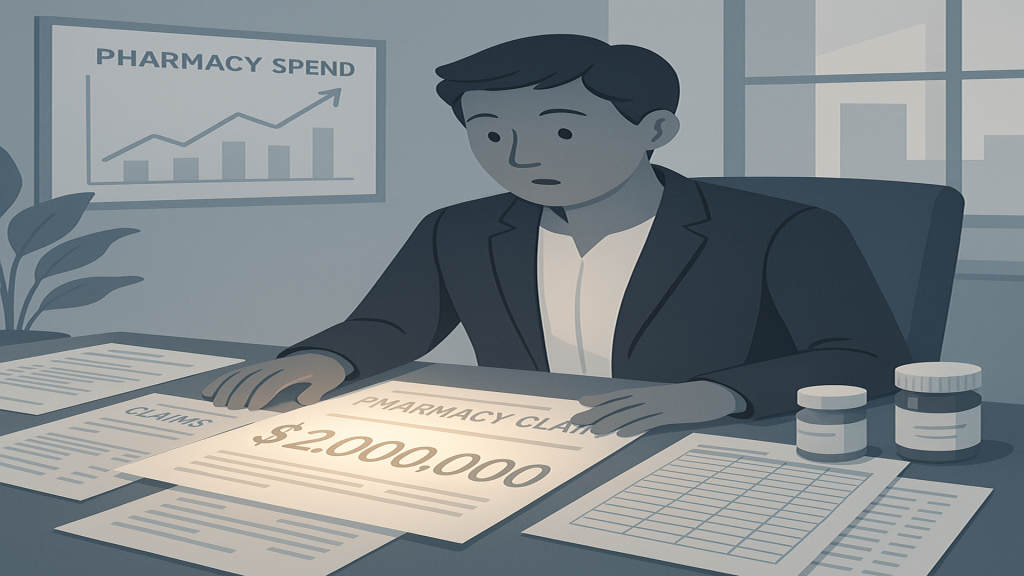
Not all pharmacy benefit waste is driven by PBMs or patients. And for larger self-funded employers or public entities, unmonitored pharmacy claims can quietly drain seven figures from the budget over time. In some cases, this can exceed $2 million in avoidable waste, depending on the scale and structure of the plan. Sometimes, it’s coming straight from the dispensing counter.
Whether it’s a neighborhood retail pharmacy, a compounding operation, or a specialty outlet working behind a white-glove reputation, pharmacy-driven fraud, waste, and abuse (FWA) is very real and very expensive.
The worst part? Most of it looks legitimate on the surface. If you’re relying on clean adjudication reports or vendor-provided summaries to spot problems, you’re missing the real story.
Pharmacy-Driven FWA: What It Looks Like
Let’s be clear: many pharmacies operate ethically. But the bad actors, and even the opportunistic ones, exploit the blind spots in your oversight structure.
Here’s how:
1. Overdispensing and Auto-Refills
Some pharmacies routinely refill medications without member requests, even when adherence or clinical need doesn’t support it. The result: stockpiled drugs, increased cost, and unnecessary waste. These refills are often masked as “member convenience,” but they’re really just revenue padding.
2. Compounded Medication Abuse
Compound pharmacies have become creative billing engines, stacking high-cost ingredients into topical creams and pain gels that offer little to no added therapeutic benefit. These compounds often bypass formulary controls and rack up thousands per script—usually without clear documentation or peer-reviewed justification.
3. Upcharging and Repackaging
Some pharmacies, including mail-order, game the system by billing for higher-priced NDCs (National Drug Codes) that represent the same drug in different packaging. For example, a 30-day supply of a generic might have five different NDCs, with wildly different reimbursement rates. Guess which one they pick?
4. Split Billing and Code Stacking
Split billing is the tactic of breaking apart a prescription into multiple claim lines to maximize reimbursement especially in specialty or infusion pharmacy settings. It’s technical, hard to detect, and completely unnecessary from a care perspective.
Code stacking is a billing practice where a provider or in the pharmacy context, often a specialty or infusion pharmacy, breaks up a service or product into multiple billing codes to maximize reimbursement, even when a single bundled code would be more appropriate.
In pharmacy benefits, code stacking can look like:
- Billing each ingredient of a compounded medication separately, rather than as a bundled compound claim.
- Submitting multiple procedure codes (often J-codes under the medical benefit) for a single therapy session, such as a biologic infusion.
- Separately billing for ancillary services like mixing, administration, and drug waste disposal when those costs should already be included in the primary service fee.
Why it’s a problem:
- It inflates claim costs artificially, driving up plan spend without delivering any additional value.
- It bypasses utilization controls that may be in place for bundled services or therapies.
- It can expose plan sponsors to compliance and audit risks, especially if the billing crosses into the medical benefit side where CMS or other regulators are watching.
Code stacking is a form of waste sometimes even fraud. And unless you’re specifically auditing for it, you may never see it happening. It often flies under the radar because the claims appear legitimate in isolation, but together they reveal a pattern of overbilling for fragmented services.
5. eVouchers, and “Incentive” Programs
Increasingly, pharmacies are also using electronic vouchers (eVouchers) at the point of sale to help members bypass plan design restrictions on high-cost brand drugs. These vouchers, typically funded by the drug manufacturer, reduce the member’s out-of-pocket costs artificially, making expensive drugs appear affordable while undermining formulary controls and driving up plan costs.
Pharmacies collect a fee from the manufacturer for processing these transactions, creating a profit loop that benefits everyone except the plan sponsor. Others collaborate with prescribers or telehealth vendors in ways that blur the line between partnership and profit scheme.
How to Stop Pharmacy-Driven Waste
- Audit early, often, and deeply. Don’t settle for annual summary audits. Use targeted claims audits that flag unusual quantities, billing codes, and refill patterns.
- Demand transparency in your network agreements. Pharmacies that want access to your members should meet specific documentation, pricing, and utilization standards.
- Carve out compound and specialty oversight. If your PBM is rubber-stamping these claims, you need an external check. Consider third-party prior auth or medical necessity reviews.
- Use real-time claims analytics. Retrospective audits are helpful but catching abuse as it happens saves more money and builds accountability into your program structure.
- Prevent the opportunity. Implement value-driven, closed formularies and pair them with tight utilization management programs. Limiting access to high-cost, low-value drugs up front eliminates the need to chase abuse after the fact.
Just Because It Paid Doesn’t Mean It’s Appropriate
One of the biggest missed opportunities in pharmacy benefit management is the use of value-driven formularies and well-executed utilization management programs. These tools can dramatically reduce waste and low-value prescribing, but only when your PBM is aligned with your best interest.
Employers also need to understand that doing this right means tolerating some disruption. Brokers call it noise, but it’s really just friction created by accountability. Expect that around 0.25% of your population, roughly 2.5 members per 1,000, may complain each month. That’s not failure. That’s progress with a feedback loop.
Elevate your expertise in pharmacy benefits management with the Certified Pharmacy Benefits Specialist® (CPBS) program, sponsored by the UNC-Chapel Hill Eshelman School of Pharmacy. Whether you’re an HR leader, finance executive, consultant, or pharmacist, this certification provides the in-depth knowledge and strategic insight needed to manage pharmacy benefits with confidence and cost efficiency. Gain up to twenty continuing education credits, enhance your career prospects, and help your organization take control of pharmacy spend. Register today to join a growing network of professionals shaping the future of pharmacy benefits management. Learn more at the Pharmacy Benefit Institute of America.
